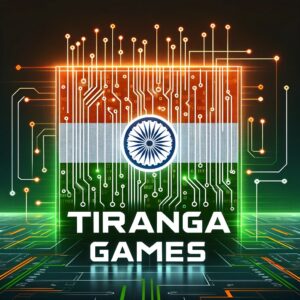In the vibrant cultural landscape of India, where traditions blend with modern innovations, the idea of the “Tiranga Game” stands out as a creative and meaningful concept. Whether seen as a physical sport, a digital adventure, or a classroom activity, the Tiranga Game symbolizes more than just play—it represents unity, patriotism, and the pride of being Indian.
The name “Tiranga” refers to the Indian national flag, which features three horizontal bands: saffron at the top, white in the middle, and green at the bottom, with the Ashoka Chakra, a navy blue 24-spoke wheel, in the center. Each color and the chakra hold deep significance. Saffron symbolizes courage and sacrifice, white stands for truth and peace, and green represents faith and prosperity. The Ashoka Chakra represents the eternal wheel of law and motion.

When these values are combined with the universal appeal of games, the result is the tiranga game—an idea that fosters national pride while entertaining and educating.
What Is the Tiranga Game?
The Tiranga Game is not a single specific game but a category or theme of games inspired by Indian patriotism and cultural unity. These games are often designed around national events such as Independence Day (August 15), Republic Day (January 26), or Gandhi Jayanti (October 2), and can be found in schools, communities, and digital platforms.
Tiranga Games aim to blend enjoyment with education, encouraging players to learn about India’s history, geography, freedom struggle, and the significance of the tricolour. Whether played by children in schoolyards or adults online, these games promote the spirit of “Ek Bharat, Shreshtha Bharat”—One India, Great India.
Types of Tiranga Games
1. Physical Tiranga Games in Schools
In many Indian schools, the Tiranga Game is organized as part of patriotic celebrations. These games are not only fun but also aim to instill a sense of unity and pride in students. Common formats include:
-
Flag Relay Races – Students run carrying the national flag and pass it to teammates. The game encourages speed, teamwork, and care for the flag.
-
Tiranga Treasure Hunts – Teams search for clues based on Indian history, culture, or geography, with each clue tied to an element of the national identity.
-
Freedom Fighter Roleplay – A game where students act out scenes from India’s freedom struggle, learning about leaders like Mahatma Gandhi, Bhagat Singh, and Subhas Chandra Bose.
These activities are highly engaging and educational, often culminating in flag hoisting and cultural programs.
2. Digital Tiranga Games
As India embraces digital learning and entertainment, developers have started creating patriotic mobile and computer games themed around the Tiranga. These include:
-
Interactive Quizzes – Players answer questions about Indian history, the Constitution, important dates, and freedom fighters.
-
Strategy Games – Players build and protect an Indian village or city from invaders, promoting unity and defense.
-
Augmented Reality (AR) Flag Hoisting – With a smartphone, players can simulate hoisting the flag at iconic locations like Red Fort or India Gate.
Such games combine technology with tradition, making them especially appealing to today’s youth.
3. Cultural and Board Games
Some Tiranga Games come in the form of board games, card games, or puzzles. These are ideal for classrooms, families, or community events:
-
India Map Puzzle – Assemble the states and union territories, learning their names, capitals, and cultures.
-
Freedom Trail Board Game – Players progress through India’s historical journey from colonization to independence, learning about important events.
-
Memory Match Cards – Match national symbols, leaders, or festivals to earn points.
These games promote learning through play, making them great tools for both fun and education.
Symbolism and Educational Value
The most powerful aspect of the Tiranga Game is the symbolism it carries. Every rule, character, or challenge in the game reflects the values of the Indian flag:
-
Saffron stands for courage: games include challenges requiring bravery and leadership.
-
White symbolizes peace: players may need to solve problems through diplomacy or teamwork.
-
Green represents prosperity: tasks could include developing villages or solving environmental challenges.
-
Ashoka Chakra promotes constant progress: games reward perseverance and continuous effort.
These symbolic layers make the Tiranga Game more than just a pastime. It becomes a tool for character building, moral education, and national awareness.
National Integration Through Games
In a country as diverse as India, promoting unity is essential. Tiranga Games often bring together players from different backgrounds, states, and languages. By playing together under the banner of the Tiranga, participants experience the strength of unity in diversity.
Multilingual versions of the game ensure inclusivity, and online leaderboards can celebrate participants from every corner of the nation. These features promote national integration, turning a game into a movement.
Respect for the Flag
While promoting patriotism through games, it’s also important to respect the Indian national flag. According to the Flag Code of India, the flag must be treated with dignity at all times. Therefore, Tiranga Games should never use the flag in disrespectful or inappropriate contexts, such as in mock battles or destruction-based gameplay.
Instead, the flag should appear as a symbol of hope, unity, and victory, reminding every player of the sacrifices made by countless Indians for freedom and democracy.
Conclusion
The Tiranga Game is more than just a game—it is a celebration of India. By blending play with purpose, it teaches children and adults alike the value of unity, freedom, responsibility, and national pride. Whether it’s a digital experience on a smartphone or a relay race on school grounds, the Tiranga Game reminds us that patriotism doesn’t always need a podium—it can be practiced in every corner of life, even through play.
As India continues to grow in the 21st century, initiatives like Tiranga Games can play a major role in shaping informed, responsible, and proud citizens who carry the spirit of the tricolour in their hearts—and not just on national holidays, but every day.









